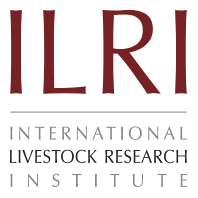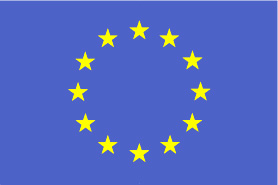Capacity Building for Sustainable Use of Animal Genetic Resources in Developing Countries
ILRI-SLU project
BackgroundEfficient utilisation of Animal Genetic Resources (AnGR) in developing countries is a prerequisite for the opportunities to meet the future demands of food to improve the livelihood of poor people. Presently 850 million people suffer from hunger and malnutrition, the latter arising mainly from inadequate availability and intake of food of animal origin. It is predicted that as the global human population annually increases by 90 Million people, food production will have to increase by 50% by the year 2020 if hunger is to be averted. In order to meet the increased demands for food of animal origin, a livestock revolution has to take place. The productivity, rather than numbers of farm animals will have to increase to avoid overgrazing and subsequent degradation of natural resources. Animals and production systems must therefore be adapted to local environmental, socio-economic and cultural conditions, and adequate genetic diversity for the unknown future needs to be ensured. It is the mission of ILRI "to help reduce poverty, hunger and environmental degradation through livestock research to enhance productivity and sustainability of agricultural systems in the developing world". This can be achieved by innovative research, in collaboration with National Agricultural Research Systems (NARS) and advanced research institutes in the developed world, and through training and information exchange. ILRI has strong research programs on characterization, improvement and conservation of indigenous AnGR. This program's main aim is improve the understanding of the livestock populations and breeds in order to provide better information for their sustainable improvement to meet future demands on animal agriculture in developing countries. Livestock improvement programs in developing countries have often failed due to inadequate or lack of infrastructure, limited technical and human resources, and failure to include adaptive traits in breeding programs. Temperate breeds may initially have shown good results in crossbreeding for increased production, however, these results are rapidly eroded when unplanned "upgrading" has taken place. The potentials of indigenous breeds have largely been neglected in most of the past and on-going breeding programmes. Recent ILRI research on characterisation of indigenous animal populations in the tropics has clearly shown the important and multiple roles that indigenous livestock play in tropical agricultural production systems. In order to sustainably utilise the AnGR in developing countries there is a great need for capacity building at all levels. This must be based on relevant research (i.e. under low input or tropical environments), utilising modern science as well as "indigenous" knowledge. Successful animal breeding programs are as much dependent on livestock and marketing policies, technical resources, socio-economic, organisational and cultural issues, as on genetics. Capacity building at universities and NARS in developing countries usually target students at MSc and PhD levels in collaborative programs with universities in developed countries. Yet the potential of utilising the existing capacities of the many NARS could be enhanced considerably, and the effects of capacity building could be much greater, if university and NARS scientists were given opportunities for continued training and collaborative projects. That way, their indigenous knowledge would be captured and integrated into modern scientific methods. Existing data show that the number of trained scientists with an animal genetics or breeding profile in developing countries is limited, and that their teaching resources are generally constrained, but variably so, depending on country and institutions, with some institutions having very scanty resources. Students seldom have access to textbooks, and very limited access to Internet information. Many faculty members also lack training in teaching or communication. In view of the background described, ILRI in collaboration with SLU (Swedish University of Agricultural Sciences), launched the project, Capacity Building for Sustainable Use of Animal Genetic Resources in Developing Countries. The main objectives are to strengthen subject knowledge and skills, as well as teaching and communication skills, of university and NARS animal scientists teaching or supervising BSc, MSc and PhD students in developing countries. Other objectives are to stimulate contacts and networking, and to develop computer-based training resources relevant for use by NARS scientists in teaching and research. The project is expected to have a large impact through the strengthened knowledge and skills of scientists in developing countries and the large number of students they reach, and also through enhanced potential for collaborative research between the universities, NARS, ILRI, and other organisations. Capacity Building is an important integral part of the ILRI research agenda on sustainable use of AnGR. Components of the Capacity Building ProgramThe project includes the following components:
The core texts of the five modules and the compendia in this training resource have been written by the project team members from ILRI and SLU. The case studies were written both by NARS scientists and by members of the project team. The content of the texts has evolved from discussions at the workshops held, and with valuable input from course participants. Core module texts and case studies have furthermore been peer-reviewed by internationally well recognized scientists well acquainted with livestock issues of developing countries or other specialist areas relevant for this training resource. The valuable comments and suggestions by all reviewers are gratefully acknowledged. It is also highly acknowledged that a lot of materials produced by others, especially by FAO, ICAR, INTERBULL and ILRI could be made available in the AGTR. The module texts, case studies, exercises, compendia and several documents referred to are found in pdf format and free for the user to copy for own use and for the students attending class. The modules and some other materials are also available in html-format for interactive use. However, when materials are to be distributed, due copyright recognition and citation must always be made. Citation guidelines are given under each module. For further information about the project, see [Progress Report 1999-2003]; Synthesis Report 2011 included in Library. Information on [Contributors] is found in the About Us menu. |

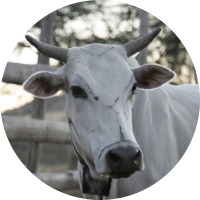

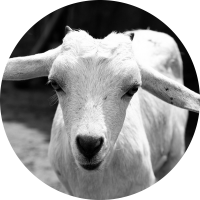
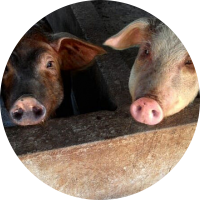
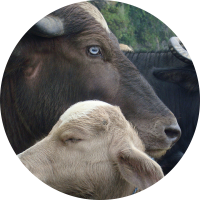
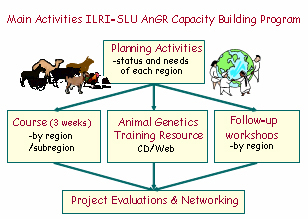 Surveys and visits to universities and research institutes in different developing countries to learn the actual situation in teaching and research, hence be able to identify areas where assistance is most needed.
Surveys and visits to universities and research institutes in different developing countries to learn the actual situation in teaching and research, hence be able to identify areas where assistance is most needed.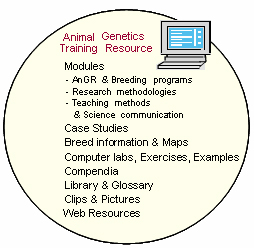 Production of computer based training resources, including introductory core texts in five different modules (covering animal breeding topics, as well as teaching methods), lecture handouts on a variety of topics, computerised exercises, case studies relevant to the different regions, breeds database etc... The training resource is continuously improved in each new release.
Production of computer based training resources, including introductory core texts in five different modules (covering animal breeding topics, as well as teaching methods), lecture handouts on a variety of topics, computerised exercises, case studies relevant to the different regions, breeds database etc... The training resource is continuously improved in each new release.